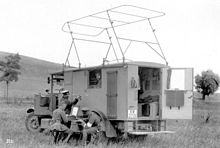Land mobile service



The land mobile radio service ( English land mobile service ) is as defined by the International Telecommunication Union a radio service between fixed and mobile land stations or between mobile land stations.
Examples
- Commercial radio
- Police radio
- BOS radio (Germany)
- Global System for Mobile Communications (GSM)
- VHF troop radio (Germany)
Germany
Frequencies
In the frequency range allocation plan of the Federal Republic of Germany, a total of 22 frequency sub-ranges from 1,606.5 kHz to 148 MHz are allocated to the land mobile radio service, in which individual frequencies or frequency channels can be allocated for civil and military users, but also for authorities and organizations with security tasks (BOS).
BOS radio
When deployed, especially in cooperation with other aid organizations, it is necessary that information can be exchanged across organizations. For this purpose the radio of the authorities and organizations with security tasks (BOS radio) is used. This belongs to the non-public mobile land radio service (nömL).
Radiotelephony in motor vehicles
The operation of a transceiver system (commercial radio, BOS radio, amateur radio , everyone's radio , cell phone / cell phone / car phone ) in vehicles built from 1995 onwards is only permitted if the radio device has an E-approval mark, otherwise the possible interference ( EMC ) of the vehicle -Electronics the general operating permit (ABE) expire.
The so-called ban on cell phones at the wheel also applies to the use of radio devices by the driver in motor vehicles. The use of two-way radios will, however, be allowed until June 30, 2020. With this exception, retrofitting with hands-free devices should be made possible, which should not be available on the market in sufficient quality. Vehicle drivers in the BOS radio (e.g. police , fire brigade , rescue service , etc.) are permanently exempt from the prohibition of use, provided that no co-driver is available.
See also
literature
-
Handheld electrical telecommunications dictionary . 2nd Edition. Volume 2
- Land radio service, mobile ; Pp. 1019-1020
- non-public mobile land radio service (nöbL) ; Pp. 1192-1194
- public mobile land radio service (öbL) ; Pp. 1214-1217
Individual evidence
- ↑ International Telecommunication Union (ITU), Implementation Regulations for Radio Services (VO Radio), 2012 edition, Article 1.26
- ↑ International Telecommunication Union (ITU), Implementation Regulations for Radio Services (VO Radio), 2012 edition, Article 1.19
- ↑ § 23 Para. 1a StVO
- ↑ § 52 Abs. 4 StVO
- ↑ Printed matter 556/17, 53rd Ordinance amending road traffic regulations (PDF) Federal Council. P. 43. July 12, 2017. Accessed January 10, 2018.
- ↑ Section 35 (9) of the StVO
